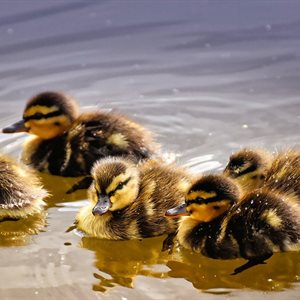Ducklings and Fledglings – Enjoying nature from a distance
As we transition from spring to summer we all hope to cross paths with fluffy ducklings and fledgling birds. It’s important to remember that these very adorable new additions may well be out and about with protective parents and it’s in everyone’s interest to keep your distance so to reduce any possible stress for the animals and increase the time they spend within your view. On a more serious note, it is also important to remember that wild birds and their nests are protected by the Wildlife and Countryside Act 1981. In this article I’m going to share some facts about the lives of young birds and their families.
Ducklings:
Most ducks prefer to nest near the water’s edge. Some of the most common birds that you might see along river banks or  reservoirs include Coots, Moorhens, Mute Swans, Bewick’s Swans, Herons, Great Crested Grebes, Canada Goose or Mallards. Most ducks will lay their eggs between mid-March – late July. Their nests are made from leaves, grasses, twigs and feathers plucked from the female duck’s breast.
reservoirs include Coots, Moorhens, Mute Swans, Bewick’s Swans, Herons, Great Crested Grebes, Canada Goose or Mallards. Most ducks will lay their eggs between mid-March – late July. Their nests are made from leaves, grasses, twigs and feathers plucked from the female duck’s breast.
The laying period is very stressful time for the female duck. A female Mallards clutch of 12 eggs equates to more than half her body weight. The eggs are laid gradually and covered to avoid detection by predators. Mallards will only start to incubate the eggs after the last one is laid. If you find a nest of duck eggs you should leave it alone; it is very unlikely to have been abandoned.
Once all the eggs have been laid the male duck will leave the female to raise the family. She will incubate the eggs for about 28 days and they will all hatch within 24 hours. The ducklings will then dry off and get used to using their legs in the safety of the nest. If the weather has been fair, after the first 10 hours their mother will lead them to water for their first feed. Ducklings cannot survive without their mother and it will be between 50 – 60 days before they’re independent.
Whilst all parents will be protective over their young it is important to note that some are also likely to be aggressive. Swans and Canada Geese are particularly large birds and they will challenge anything that gets too close to their chicks. Swans and Canada Geese can have up to 7 or 8 chicks, that’s a lot of babies to keep an eye on! If you are walking your dog in an area where you expect birds may be nesting, you really should keep your dog on the lead.
Whilst there is plenty of food for the ducks to forage, they will of course appreciate any treats that you’d like to share. In the past I’m sure we have all fed an old crust of bread to the ducks. In recent years this has been shown to not necessarily be the best option. You can buy special duck pellets from supermarkets, garden centres or online or you can take an alternative from your own kitchen. Sweetcorn - frozen, tinned or fresh is a sweet and popular treat. You could also try lettuce that’s slightly past its peak, frozen peas, rolled oats, mixed seeds, left over takeaway rice or uncooked rice.
Fledglings:
If you see a fledgling bird in your garden or out on your walk, however tempting it may be you really should leave it well alone. Fledglings are extremely unlikely to have been abandoned. The parent birds are probably off collecting food or keeping a watchful eye from a distance as the chick gains independence. If you are confident that a fledgling has been abandoned or is injured then you should contact the RSPCA. If you find a bird that does not have all of its feathers it has probably fallen out of the nest. You should only put it back if the chick is strong and healthy and you are confident that you have identified the correct nest. Birds have a poor sense of smell so handling the baby bird will not cause the parents to abandon it. Some parents can tell if there is something wrong with the chick and it may have been ejected so that they can concentrate on the healthy hatchlings.
Most garden bird chicks will leave the nest when they are fully feathered, but cannot fly. It’s important to keep this in mind as it may explain why they are hopping about in the bushes or on the ground rather than flying away. The only exceptions to this rule are Swifts, Swallows and House Martins. You can support any new young families in your garden by putting out feeders. Fat balls and mealworms are perfect for building up the strength of young birds. If you are lucky enough to have very young birds in your garden, place the mealworms in a shallow saucer with a few drops of water to soften them up.
The next time you’re out and about and come across an adult or juvenile bird you can’t identify, why not try the RSPB Bird Identifier. Enter in key identifiers such as size, colour or where you saw it then click through to hear the calls or find out more. Taking a moment to learn something new about the wildlife around us helps to build our connection with nature and boost our own wellbeing.